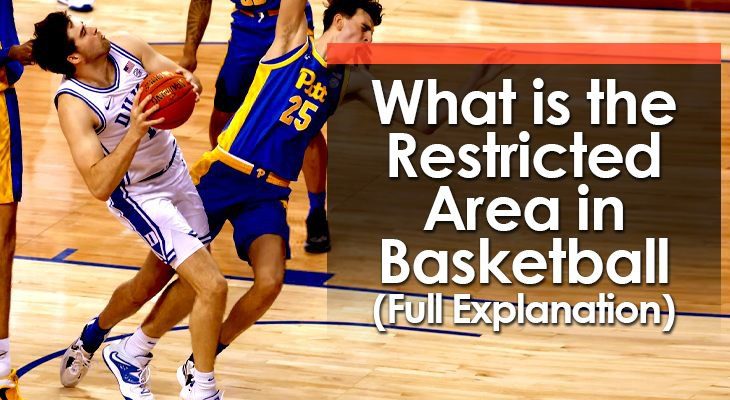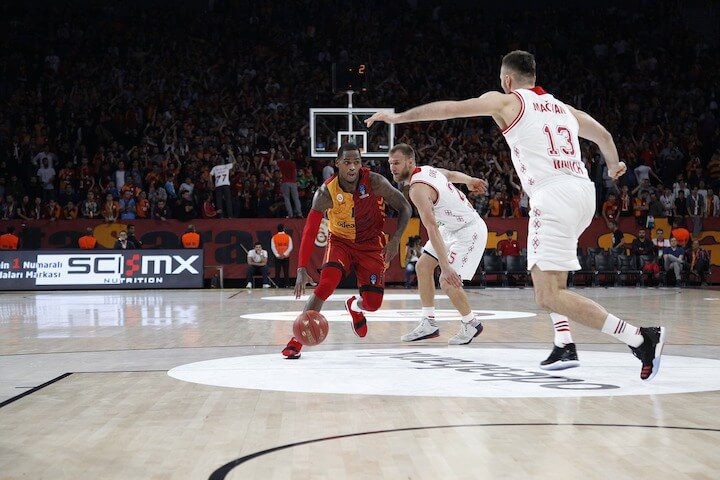
You’ve probably noticed that basketball courts have lines all over the place.
- Baselines
- Sidelines
- Three-point lines
- Free throw lines
- And many more
The newest line that’s been added to a basketball court isn’t very big, but it’s a very important one for players, coaches, and referees alike.
It’s the small arc located in the lane and it’s there to designate what is referred to as the “restricted area” on the court.
In this article, I will dive into what exactly the restricted area is, why this line has been added to the court, and how you can coach your players to use it to their advantage.
What is the Restricted Area in Basketball?
The restricted area is a semi-circular arc under the rim.
Its primary purpose is to enhance player safety by limiting collisions between offensive and defensive players under the basket. Any secondary defenders who attempt to draw a charge in this area will automatically get called for a blocking foul.
It's an area marked by a semicircle that extends 4 feet out from the center of the basket and extends to even with the front edge of the backboard on both sides of the hoop.

Why Was the Restricted Area Added to the Court?
The restricted area arc was first instituted in the NBA during the 1997-98 season.
And it was basically added for two primary reasons:
1. The main reason the restricted area was added was to prevent injuries from occurring to airborne players.
Before the arc was added, secondary defenders would step in to draw a charge on players who were about to take off no matter how close to the basket they were, making a collision unavoidable.
The restricted area makes it much less beneficial for secondary defenders to attempt taking a charge too close to the basket since they will automatically be whistled for a foul.
2. The second reason for the addition of the restricted area is to help make the officials’ job easier in making the block/charge call.
While the block/charge call is typically a judgment call, the addition of the arc designating the restricted area takes all of the judgment out of it, at least near the rim.
Important Things to Note About the Restricted Area
1. It extends all the way to the ceiling.
Even if a secondary defender’s heel isn’t technically touching the ground inside the restricted area arc, they are still considered to be in the within it, resulting in a whistle for a blocking foul if there is contact.
2. A primary defender CAN still draw a charge inside the restricted area.
While a help defender cannot draw a charge inside this area, the offensive player’s original defender can still draw a charge near the basket.
3. Not all contact inside the restricted area is an automatic foul.
A secondary defender can make contact with the offensive player inside the restricted area without being whistled for a foul.
But for this to be the case, the defender must follow the principle of verticality, being completely vertical and staying squared up to the offensive player.
4. The restricted area does not extend to the baseline.
The arc ends at the front edge of the backboard, so there is an area along the baseline that is not considered to be inside the restricted area.
Therefore, on a baseline drive, a secondary defender is able to draw a charge on a drive if the drive occurs between the backboard and the baseline.
Using the Restricted Area to Your Advantage
Even though you may not technically have a restricted area on the basketball courts you play on, it is likely just a matter of time before it gets added.
You see, having different sets of rules between different levels of basketball makes it difficult for players as they progress, not to mention coaches and referees.
So there is a push to make the game more uniform throughout from top to bottom. At some point, chances are there will be a restricted area arc for all games that you coach.
Which means it’s never too early to start working with your players on using it to your advantage.
Offensively...
Driving players need to recognize when a help defender is stationed in the restricted area. Realizing this should allow your players to drive confidently to the basket knowing they will at the very least go to the free throw line if there is any contact on the drive.
Defensively...
Teaching players to avoid the restricted area while helping should lead them to get to good defensive position sooner. Anticipating drives and trying to get positioned out from under the rim to stop the ball and potentially even draw a charge will make your team that much better defensively, whether there is a restricted area or not.
Conclusion
The restricted area on a basketball court is very clearly marked with an arc for a reason.
Most people think the primary reason it is there is to help officials with the block/charge call.
And they’re not entirely wrong.
But the more important reason it’s on the floor is to help prevent players from getting injured.
If players know they can’t legally get set to draw a charge outside the arc, then they won’t bother trying to do it. And this will then prevent unnecessary contact and falling from both the offense and defense.
So next time you’re watching a basketball game with the restricted area arc, realize just how important that little line is.
